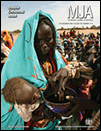History
The possible causes of the pandemic of peptic ulcer in the late 19th and early 20th century
Abstract
- Helicobacter pylori is established as a cause of peptic ulcer (PU).
- Less well recognised is that an epidemic of PU began around the middle of the 19th century, reached a peak at the turn of the century, and is now on the wane.
- As the epidemic developed, the risk of PU increased in successive generations throughout life. Then the epidemic diminished in successive generations.
- The risk of gastric ulcer (GU) was highest in people born around 1885, while the risk of duodenal ulcer (DU) was highest in those born about 10–30 years later.
- H. pylori infection offers an inadequate explanation of the PU epidemic.
- Although the epidemic coincided with a major rise in cigarette smoking, PU then declined in spite of an increased incidence of smoking.
- None of the other possible causes of ulcer (non-steroidal anti-inflammatory drugs, stress or diet) satisfactorily explains the epidemics of GU and DU and their asynchronicity.
- The best, but inadequate, explanation for the epidemic is the coincidence of the acquisition of a new potent strain of H. pylori in childhood and the uptake of smoking in adult life.




